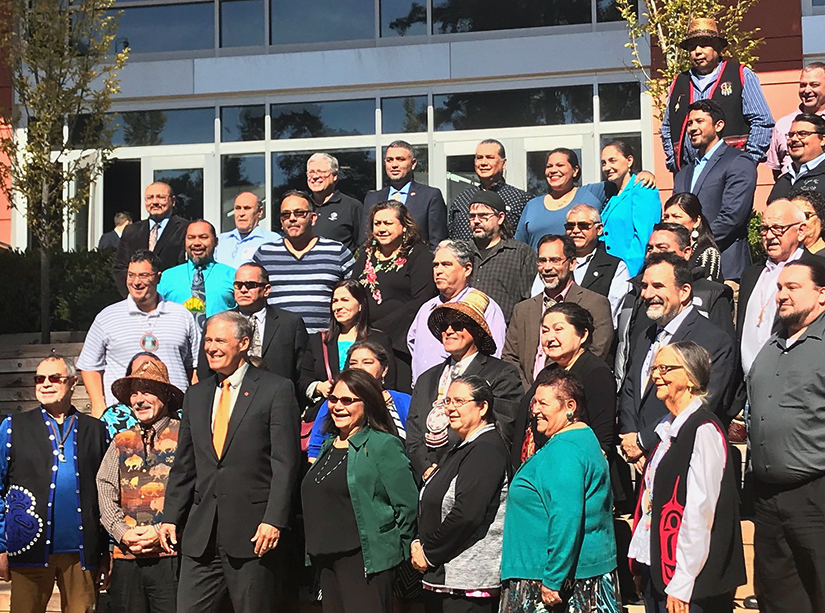Working Government-to-Government
Tribal sovereignty is the legal concept behind successful collaboration with tribal governments. A government-to-government relationship is the application of that concept, the legal framework underlying the agreements, compacts, contracts, and other negotiated arrangements that define the terms of collaboration. In practice, a government-to-government relationship means that any policy decisions affecting a tribe must be negotiated and coordinated with the tribal government by the state or federal government through formal processes, such as consultations.

Governor Jay Inslee and Washington state tribal leaders at the 2018 Centennial Accord meeting.
Tribal governments are parallel to the federal government and, to some extent, the states—though not to county or city governments. As a result, tribes might be reluctant to work government-to-government with local agencies, and collaborations might be more successful if they involve both the state and local governments.
Formal agreed-on processes are outlined by the U.S. federal government as well as by individual states. For example, Chapter 43.376 of the Revised Code of Washington defines Washington State’s government-to-government relationship with Washington tribes and outlines how the relationship will be implemented in practice.
Consultation
One cornerstone of the government-to-government relationship is consultation. Federal and state governments have a legal obligation to consult with tribes about any policy that would have an impact on them with as much advance notice as possible. Impact on tribes is defined broadly, and the obligation to consult applies even if programs and policies are solely or primarily unrelated to tribal issues. This process helps the U.S. government fulfill its duty to ensure that its laws and policies do not violate treaty rights or tribal sovereignty.
The obligation to consult is not fulfilled simply by inviting tribal representatives to participate in general public comment processes. It is also not enough to only communicate and coordinate at the staff level among federal, state, or local and tribal employees. Consultation is a formal process that requires:
- Involving tribes as early as possible
- Identifying the appropriate tribal authorities to consult
- Facilitating consultation at multiple stages of program and policy development
- Determining the appropriate format for consultation
- Preparing and presenting information
- Revising program and policy plans based on consultation
- Implementing program or policy with continued consultation as needed 19
Consulting with tribes through a government-to-government relationship is important. In addition to it being a legal requirement, it is also an essential step in building successful policies.
When seeking to work with a specific tribe, it is important to remember that:
- All tribes have unique processes and agreements specific to their government-to-government relationships with the U.S. and each state government. These should be laid out in the treaties and federal legislation that apply to each individual tribe. 20
- The government-to-government relationship between tribes and the U.S. federal government is distinct from the relationship the U.S. federal government has with states and other sovereign nations.
Tools and Supports for Navigating Tribal Government-to-Government Relationships
- Dear tribal leader letters. The consultation may take many forms including meetings and reports, but one of the most important and standard formats for initiating consultation is the Dear Tribal Leader letter. A Dear Tribal Leader letter is a formal, mailed communication that describes the policy or program under consideration and its anticipated tribal impact.
- Strong personal relationships. Tribal leaders confirm that personal relationships with local government officials and staff are an important factor in the success of collaboration. It’s important to invest in these relationships and build them by attending tribal events and meeting tribal leaders face to face before issues and conflicts arise.
- Formalized relationships. These could be in the form of accords or Mutual Aid Agreements, such as Washington State’s centennial accord.
- Consultation policies. An example of this is the Tribal Consultation and Urban Indian Health Program Confer Policy created by the Oregon Health Authority.
Additional Resources
- Health and Human Services Tribal Consultation Policy
- Sample Dear Tribal Leader letters from Indian Health Service
- Washington state Dear Tribal Leader letter
- Sample tribal consultation policy from Alaska Department of Health and Social Services and the Office of the Commissioner
- The Washington Centennial Accord